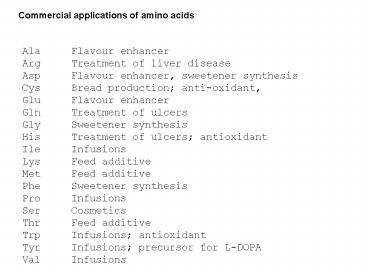Ala Flavour enhancer - PowerPoint PPT Presentation
1 / 12
Title:
Ala Flavour enhancer
Description:
... Flavour enhancer. Arg Treatment of liver disease. Asp Flavour enhancer, sweetener ... Glu Flavour enhancer. Gln Treatment of ulcers. Gly Sweetener synthesis ... – PowerPoint PPT presentation
Number of Views:261
Avg rating:3.0/5.0
Title: Ala Flavour enhancer
1
Commercial applications of amino acids
Ala Flavour enhancer Arg Treatment of
liver disease Asp Flavour enhancer, sweetener
synthesis Cys Bread production
anti-oxidant, Glu Flavour enhancer Gln
Treatment of ulcers Gly Sweetener
synthesis His Treatment of ulcers
antioxidant Ile Infusions Lys Feed
additive Met Feed additive Phe Sweetener
synthesis Pro Infusions Ser Cosmetics Thr
Feed additive Trp Infusions
antioxidant Tyr Infusions precursor for
L-DOPA Val Infusions
2
In industry, amino acids can be made by chemical
synthesis, or they can be obtained from
overproducing bacteria. Corynebacterium
glutamicum naturally overproduces glutamate.
Biological production methods are easier, cleaner
and only give L amino acids.
3
Fermentation tanks used for microbiological
production of glutamate and lysine, Hofu, Japan
Tanks are 100ft high and contain 63,420 gallons
4
Inhibitors of essential AA biosynthesis can be
used as herbicides
The weedkiller Roundup contains glyphosate.
Glyphosate kills plants by inhibiting aromatic AA
biosynthesis.
GM crops have an engineered glyphosate-resistant
biosynthetic enzyme EPSPS.
5
Secondary metabolism - produces many valuable
bioactive compounds including antibiotics,
anticancer drugs, immunosuppressants, cholesterol-
lowering agents etc.
6
Metabolism
- Hundreds of reactions
- Only a few different types of reactions
Most are simple chemical transformations
that are catalysed by enzymes.
7
Important types of biochemical reactions.
1. Reactions that make or break carbon-carbon
bonds.
2. Oxidations and reductions
3. Eliminations, isomerisations and
rearrangements
4. Group transfer reactions
8
1. Reactions that make or break C-C bonds often
involve attack of a stabilised carbanion on an
electron-deficient carbon atom.
9
Carbonyl groups (aldehydes and ketones)
O is more electronegative than C
O withdraws electrons from the C-O double bond
The C atom has a ve character. This makes
carbonyl groups reactive.
10
Carbon-hydrogen bonds can be broken to give a
carbanion and a proton.
The two bonding electrons remain on the carbon
atom.
Normally, carbanions do not form unless there is
some means of stabilising them.
11
Carbonyl groups can stabilise carbanions that
form on adjacent C atoms.
Enolate anion
The negative charge is delocalised over 3 atoms.
12
In an aldol condensation, a stabilised carbanion
adds to another carbonyl group to form a C-C bond.
The reverse reaction (aldol cleavage) can also
occur e.g during glycolysis fructose 1, 6
diphosphate is cleaved to give two trioses, DHAP
and GAP































